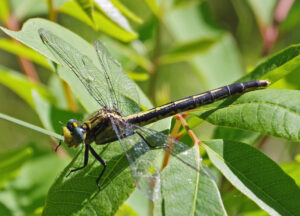Note: All links below go to external sites.
Howdy, BugFans,
We end this set of 50 (by the BugLady’s count, this is episode # 650) with a lovely dragonfly that the BugLady looks forward to seeing every year because of those dynamite, blue eyes (and despite the fact that they can be difficult to photograph at the place where she usually finds them because they sit on lily pads that are squarely between the camera and the bright sun). Despite their name, Lilypad Clubtails are not as reliant on lily pads as Lilypad Forktails, of previous BOTW fame.
Lilypad Clubtails are in the family Gomphidae. Male clubtails do, indeed, have a noticeable club – a widening of the last three segments of the abdomen that is more obvious in some species than in others (females may have a minimal club). Male clubtails often perch and even fly with the club raised and on display. Dragonflies in most other families have eyes that touch over the tops of their heads (like this darner), but clubtails’ eyes are separated. There are about 100 clubtail species in North America (900 worldwide), and they are favorites of many dragonfly fans (you can browse the clubtails here).
Many clubtails are found solely around running water, but Lilypad Clubtails (Arigomphus furcifer) and others in the same genus are known as the pond clubtails because of their preference for still waters. The BugLady mostly finds Lilypad Clubtails at the edges of ponds that have lots of vegetation in and under the water and along the shoreline, but she also sees them in quiet bays on the edge of the Milwaukee River. They’re an early dragonfly (late May to mid-summer) and a northern dragonfly, seen from far eastern Minnesota north well into Canada, east to New England and the Maritime Provinces, and south to New Jersey and Ohio. They’re found across Wisconsin but are not common.
Their life story is pretty typical for a pond clubtail. Males and females feed along sunny edges near their breeding habitat, snagging small insects from the air. After mating, they separate and she, unguarded by the male and lacking an ovipositor that would allow her to place an egg inside a plant stem, flies just above the water and washes the eggs off the tip of her abdomen by tapping it on the water (every five seconds, says Kurt Mead in Dragonflies of the North Woods). Naiads (immature dragonflies) live under water, eating any aquatic invertebrates that they can wrap their mouthparts around. When it’s time for them to emerge as adults, they climb onto water lilies or other floating leaves or up onto the shore to shed their skin. Dragonflies hold their wings out to the side at rest, but the Lilypad Clubtail that’s sitting on the basswood leaf is so new that it can still fold its wings together.
The Wisconsin Odonata survey tells us that “Clubtail species are very similar to each other in some aspects; careful inspection is needed to identify them.” The BugLady felt pretty good about being able to identify Lilypad Clubtails by the male’s yellow, inwardly-curved claspers, but BugFan Freda reminded her that there are two similar-looking clubtails in southeast Wisconsin – the Horned Clubtail
, and the Unicorn Clubtails
The BugLady went through her Lilypad Clubtail shots and had to relabel a few.
For up-to-date information about which dragonflies and damselflies are where, and what they look like (and to report your sightings when the odonates start up in “a few months”), see here.
The BugLady
